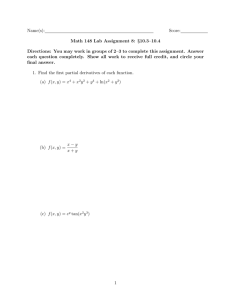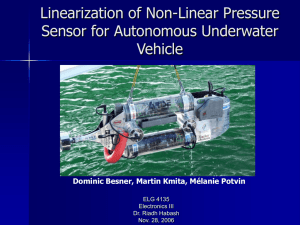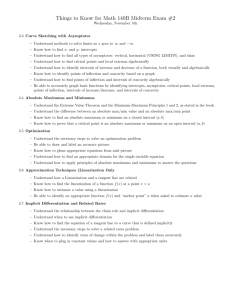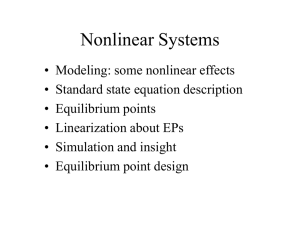Document 10948438
advertisement
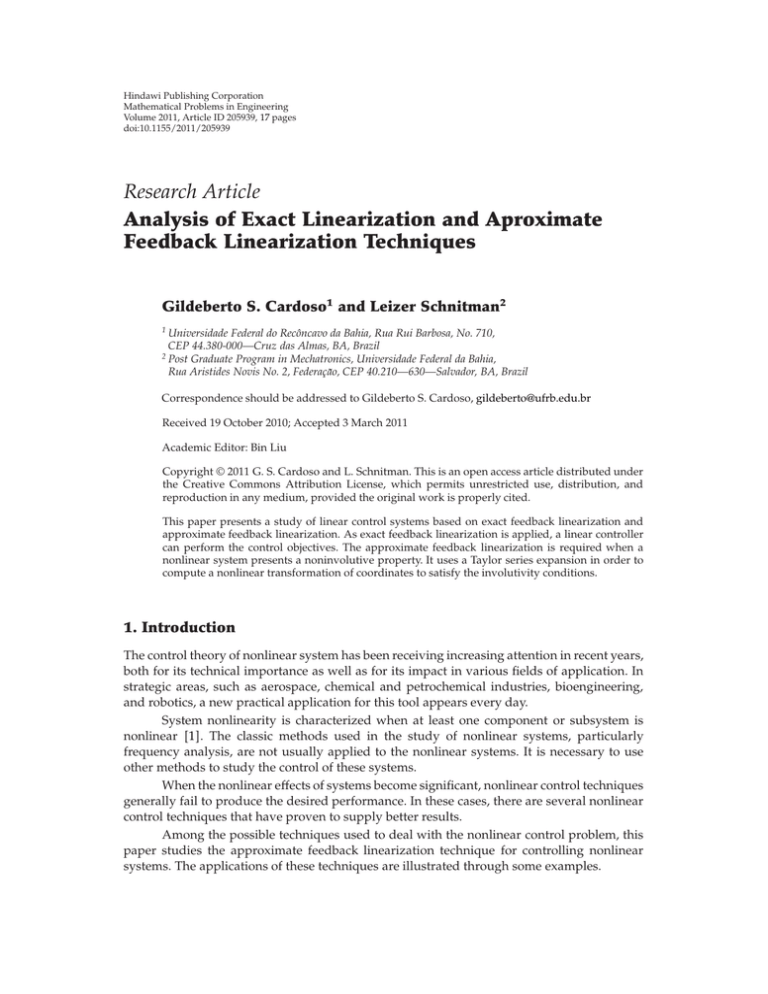
Hindawi Publishing Corporation
Mathematical Problems in Engineering
Volume 2011, Article ID 205939, 17 pages
doi:10.1155/2011/205939
Research Article
Analysis of Exact Linearization and Aproximate
Feedback Linearization Techniques
Gildeberto S. Cardoso1 and Leizer Schnitman2
1
Universidade Federal do Recôncavo da Bahia, Rua Rui Barbosa, No. 710,
CEP 44.380-000—Cruz das Almas, BA, Brazil
2
Post Graduate Program in Mechatronics, Universidade Federal da Bahia,
Rua Aristides Novis No. 2, Federação, CEP 40.210—630—Salvador, BA, Brazil
Correspondence should be addressed to Gildeberto S. Cardoso, gildeberto@ufrb.edu.br
Received 19 October 2010; Accepted 3 March 2011
Academic Editor: Bin Liu
Copyright q 2011 G. S. Cardoso and L. Schnitman. This is an open access article distributed under
the Creative Commons Attribution License, which permits unrestricted use, distribution, and
reproduction in any medium, provided the original work is properly cited.
This paper presents a study of linear control systems based on exact feedback linearization and
approximate feedback linearization. As exact feedback linearization is applied, a linear controller
can perform the control objectives. The approximate feedback linearization is required when a
nonlinear system presents a noninvolutive property. It uses a Taylor series expansion in order to
compute a nonlinear transformation of coordinates to satisfy the involutivity conditions.
1. Introduction
The control theory of nonlinear system has been receiving increasing attention in recent years,
both for its technical importance as well as for its impact in various fields of application. In
strategic areas, such as aerospace, chemical and petrochemical industries, bioengineering,
and robotics, a new practical application for this tool appears every day.
System nonlinearity is characterized when at least one component or subsystem is
nonlinear 1. The classic methods used in the study of nonlinear systems, particularly
frequency analysis, are not usually applied to the nonlinear systems. It is necessary to use
other methods to study the control of these systems.
When the nonlinear effects of systems become significant, nonlinear control techniques
generally fail to produce the desired performance. In these cases, there are several nonlinear
control techniques that have proven to supply better results.
Among the possible techniques used to deal with the nonlinear control problem, this
paper studies the approximate feedback linearization technique for controlling nonlinear
systems. The applications of these techniques are illustrated through some examples.
2
Mathematical Problems in Engineering
2. Analysis of Necessary and Sufficient Conditons for
Exact Feedback Linearization
The objective of this section is to detail the necessary and sufficient conditions for inputstate linearization. These conditions are limiting to the implementation of the exact feedback
linearization technique. However, as a solution to this problem, the approximate linearization
technique will be described.
Initially, we consider a single input ut for a nonlinear system, given by
ẋ fx gxu.
2.1
This system is known as linear in the control and linear in the input, among other
denominations. The functions fx and gx are C∞ vectors with field in ẋ ∈ Rn .
The system in the form 2.1 is input-state linearizable if there is a region Ω in Rn that
meets the following conditions:
i the vector field {g, adf g, . . . , adn−1
f g} is linearly independents in Ω,
j
ii the set of vectors adfi g, adf g span{g, adf g, . . . , adfn−2 g} for i, j 0, 1, 2, . . . , n − 2
is involutive,
j
where adfi g, adf g indicates the Lie bracket and adfi g is defined as 2:
adfi g g, adfi−1 g .
2.2
The first condition indicates the system controllability in which the vector fields
{g, adf g, · · · , adfn−1 g} are equivalent to the controllability matrix for linear systems
b Ab A2 b · · · An−1 b 1.
The second involutivity condition enables to find out a new vector of linear state
through the states feedback.
3. Exact Feedback Linearization
If the aforementioned conditions were satisfied, then it is possible to find a scalar function
φx such that
∂φx i
adf g 0,
∂x
i 0, 1, 2, . . . , n − 2,
∂φx n−1
adf g /
0,
∂x
3.1
3.2
where φx defines a state transformation z given by 1
z Tx L0f φx L1f φx · · · Ln−1
f φx .
3.3
Mathematical Problems in Engineering
3
c
l
u
m
Figure 1: Simple pendulum.
A control input is then obtained through
u αx βxv −Lnf φx
Lg Ln−1
f φx
1
Lg Ln−1
f φx
v,
3.4
such that the closed-loop system has a new set of variables in linear state
ż Az bv,
3.5
where
⎡
010
⎢
⎢ 001
⎢
⎢
A⎢
⎢· · ·
⎢
⎢ 000
⎣
000
···
···
···
···
···
0
⎤
⎥
0 ⎥
⎥
⎥
· · ·⎥
⎥,
⎥
1 ⎥
⎦
0
⎡
0
⎤
⎢ ⎥
⎢0⎥
⎢ ⎥
⎢ ⎥
⎥
b⎢
⎢· · ·⎥.
⎢ ⎥
⎢0⎥
⎣ ⎦
1
3.6
A and b are in the canonical form of Brunovski however, there is no loss of generality; as
every linear system may be written in the companion form by a state transformation 1.
3.1. Inverted Pendulum Linearization
Figure 1 shows an overview of a single pendulum. The pendulum may be described as a fixed
end connected to a sphere through an inflexible rod and can be swung when stimulated by a
force u or has a nonzero initial condition.
The model of a pendulum is given by
ẋ1 x2 ,
ẋ2 −
g
1
b
sinx1 − x2 u,
l
m
ml
3.7
where g, l, m, b, x1 , and x2 are, respectively, gravitational acceleration, length of rod, mass of
the sphere, friction coefficient, rotation angle, and angular speed.
4
Mathematical Problems in Engineering
3.1.1. Calculation of Controllability and Involutivity of the Simple Pendulum
As it is a second-order system, the vector field for verifying the controllability will be formed
by{g, adf g}, where,
⎡
0
⎤
⎢ ⎥
g ⎣ 1 ⎦,
ml
⎡
⎤
1
⎡
⎤ ⎡
⎤⎡ ⎤
−
x2
0
1
0
⎢
⎥
0 0 ⎢
⎥ ⎢
⎥⎢ ⎥ ⎢ ml ⎥
adf g −
⎢
⎥.
⎣ g
⎦
⎦
⎣
⎦
⎣
g
1
b
b
⎣ b ⎦
0 0 − sinx1 − x2
− cosx1 −
ml
l
m
l
m
− 2
m l
3.8
Hence, the vector field {g, adf g} will be given by
⎡
⎤
1
0
−
⎢
ml ⎥
⎢
⎥
{g, adf g} ⎢
⎥.
⎣ 1
b ⎦
−
ml m2 l
3.9
The vector fields are linearly independent; therefore, the simple pendulum is controllable.
In order to calculate the involutivity of the system, it is necessary to calculate the Lie
bracket of {g, adf g} and verify if it may be written as a linear combination of g and adf g
⎡ ⎤
0
⎢ ⎥
⎢0⎥
⎢ ⎥
g, adf g ⎢ ⎥.
⎢0⎥
⎣ ⎦
0
3.10
The Lie bracket of {g, adf g} is equal to zero, as the column vectors of the matrix are
constant. Therefore, the system is involutive, which satisfy the conditions to apply input-state
linearization.
3.1.2. Calculation of the New State Vector and the Input Variable Using
Differential Geometry
The first component of the state vector T1 should be obtained through the expression 3.1.
As the order of the system is equal to 2, equation ∂T1 becomes
∂T1
∂x1
⎡ ⎤
0
∂T1 ⎢ ⎥
⎣ 1 ⎦ 0,
∂x2
ml
3.11
Mathematical Problems in Engineering
5
resulting in
1 ∂T1
0.
ml ∂x2
3.12
∂T1
0.
∂x2
3.13
Therefore,
From 3.2,
∂T1
∂x1
⎤
⎡
1
⎢ − ml ⎥
∂T1 ⎢
⎥
0,
⎥/
⎢
⎣
∂x2
b ⎦
− 2
m l
3.14
solving
−
1 ∂T1
0.
/
ml ∂x1
3.15
Therefore,
∂T1
/ 0.
∂x1
3.16
In order to satisfy the last equation, T1 x1 has to be chosen.
We use 3.3 to compute the second component of the new state vector T2
⎡
x2
⎤
∂T1 ⎢
⎥
⎦
⎣
∂x1 − g sinx1 − b x2
l
m
⎤
⎡
x2
⎢
⎥
1 0 ⎣ g
b ⎦ x2 .
− sinx1 − x2
l
m
T2 Lf T1 3.17
This gives the new state vector
T T1 T2 x1 x2 .
3.18
The new input variable is calculated from 3.4, where
− g/l sinx1 − b/mx2
αx mg sinx1 lbx2 ,
1/ml
1
−ml.
βx −
1/ml
3.19
6
Mathematical Problems in Engineering
u = g(x, v)
v = −kT z
ẋ = f(x, u)
x
z = T(x)
Figure 2: Control structure.
Therefore,
u mg sinx1 lbx2 − mlv.
3.20
This results in a linear system
Ṫ1
Ṫ2
T2
−v
.
3.21
The system block diagram may be represented as shown in Figure 2.
The control structure, according to Figure 2, has two feedbacks. The first feedback is
responsible for system linearization, eliminating the existing linearity. The second feedback
is the controller project based on the state feedback.
3.2. The Need for Differential Geometry to Calculate the Exact Linearization
The linearization result shown previously might be obtained directly from
u
1
−fx v.
gx
3.22
When this procedure is applied, the linearization calculation would be significantly less.
The problem occurs when the control law obtained by this means does not permit the exact
linearization.
As an example of the aforementioned problem, consider a nonlinear system given by
−3x1 2x2 ex1
,
fx −x2 ex1
0
.
gx x1
3.23
3.24
Mathematical Problems in Engineering
7
Applying 3.22, we will obtain:
1
x2 ex1 v.
x1
u
3.25
This result does not make equation 3.23 a linear system. It requires a variable transformation
by inference or by differential geometry. An approach through differential geometry is more
generic and can be implemented in software through simple programming.
3.2.1. The Use of Differential Geometry to Linearize the Previous Example
The first component of the state vector Tx is obtained through
0
gx 0.
∇T1 x adfx
0
As adfx
gx 0
x1
3.26
, we will have
∂T1 x ∂T1 x
∂x1
∂x2
0 x1
0.
3.27
Therefore,
∂T1 x
0.
∂x2
If adfx gx −2x1
3x1 2x2 ex1 x1 ex1
3.28
, obtained through the expression 3.2, then
∂T1 x ∂T1 x
∂x1
∂x2
−2x1
−3x1 2x2 ex1 x1 ex1
0.
/
3.29
Substituting the result of 3.28 in the matrix ∇T1 x, we obtain
−2x1
∂T1 x
0
/ 0.
∂x1
−3x1 2x2 ex1 x1 ex1
3.30
Consequently,
−2x1
∂T1 x
0.
/
∂x1
3.31
0; therefore, we should choose the new state T1 x
This expression indicates that ∂T1 x/∂x1 /
in such way that it satisfies this condition.
8
Mathematical Problems in Engineering
x3
x2 = ẋ1
x4 = ẋ3
u
x1
Figure 3: Inverted pendulum.
Choosing T1 x x1 , we obtain
−3x1 2x2 ex1
T2 x Lf T1 x ∇T1 x
−x2 ex1
−3x1 2x2 ex1
−3x1 2x2 ex1 .
1 0
−x2 ex1
3.32
With the new state space given by z Tx,
z Tx T1 x
T2 x
x1
−3x1 2x2 ex1
.
3.33
4. Approximate Feedback Linearization
There are situations in the design of controllers where the nonlinear terms are significant to
the extent that failure to consider these terms in the system model could cause it to perform
badly or to act restricted to a narrow operation band.
For systems where the nonlinear terms cannot be ignored, however, a physical model
very close to reality can be made. The solution is to use exact feedback linearization. In this
case, it is possible to linearize the system and apply linear control methods. Unfortunately
exact linearization cannot be used for noninvolutive systems, as they do not satisfy the
aforementioned conditions.
To solve this problem, the approximate feedback linearization, formulated by Krener
3, has been adopted using differential geometry techniques.
The approximate feedback linearization may be considered a near equivalent version
of the exact feedback linearization. On the other hand, it offers the possibility to control
noninvolutive systems, which was not possible using exact linearization. This new approach
has recently been used in several applications.
As an example to validate this technique, the inverted pendulum model Figure 3
with its characteristic nonlinear dynamic and an unstable open loop will be used. It is a classic
Mathematical Problems in Engineering
9
problem in control theory and is widely used as a benchmark for testing of control algorithms
adaptive control, robust control, fuzzy, etc..
4.1. Approximate Linearization Calculation
The approximate feedback linearization has been applied in cases where exact linearization
is not feasible or has not yielded satisfactory results 4. This process consists of finding
approximate output functions that satisfy the involutivity condition up to determined system
order.
The basic idea is 5, given
ẋ fx gxu,
4.1
where x ∈ R.
Considering a state transformation in the control variable, we obtain
z Wx,
4.2
u αx βxv,
so that
ż Azx bv Op1 x, u,
4.3
where A ∂fx0 /∂x, b gx0 , x x − x0 , fx0 0.
We apply a state transformation in the control variable such as
1
zx x zxx x0 x2 O3 x, u,
2
4.4
1
vx, u u vx x vxx x2 vxu xu O3 x, u,
2
4.5
where
zxx
∂2 zx0 ∂x2 ,
xx0
vxx
∂2 vx, u ∂x2 ,
xx0
vxu
∂2 vx, u ∂x∂u .
4.6
xx0
Differentiating 4.4, we obtain
żx ẋ zxx xẋ.
4.7
żx fx gxu fxzxx x gxzxx xu.
4.8
Substituting 4.1 in 4.7,
10
Mathematical Problems in Engineering
Expanding in a Taylor series,
∂gx0 1 ∂2 fx0 2
∂fx0 x
żx Ax gx0 u zxx gx
u O3 x, u.
z
0 xx x
∂x
2 ∂x2
∂x
4.9
Substituting 4.4 and 4.5 in 4.3, we obtain
1 ∂fx0 żx Ax gx0 u zxx gx0 vxx x2 gx0 vxu xu O3 x, u.
2
∂x
4.10
Equalizing the second order term of 4.9 and 4.10 so that the unknown constants
zxx , vxx , vxu cancel out the second-order terms x2 , xu, we obtain
∂fx0 ∂2 fx0 zxx − gx0 vxx 0,
∂x
∂x2
∂gx0 gx0 zxx − gx0 vxu 0.
∂x
4.11
Thus, there is an approximate output W1 x, such as the set of vectors {g, adf g, . . . , adfn−2 g}
are involutive until certain order p 6. In other words, the gradient W1 x multiplied by the
Lie bracket of f and g is equal to the superior terms p 1. The following equation illustrates
this:
∇W1 xadfi g Op1 x,
i 0, 1, 2, . . . , n − 2.
4.12
In order to find vector W1 , it is necessary to expand the involutive distribution DI {g, adf g, . . . , adfn−2 g} in a Taylor series on an equilibrium point x0 . The expansion of the
involutive distribution in x0 can be represented through the following equation:
DI x DI x0 n
∂DI x0 k−1
∂xk
xk n
∂2 DI x0 1 xk xi O3 x,
2 k,i−1 ∂xk ∂xi
4.13
where xk xk − x0 and xi xi − x0
This expansion is carried out in order to obtain an involutivity until a certain order p,
where p indicates the order in which the involutive distribution is expanded in a Taylor series
to satisfy the involutivity condition. Therefore, the calculation of the approximate output
function W1 is done through the equation
T
D0 D1 · · · Dp ∇W1 0n−1x1 ,
4.14
Mathematical Problems in Engineering
11
where,
D0 DI x0 ,
D1 n
∂DI x0 ∂xk
k1
xk ,
..
.
Dp 4.15
n
∂p DI x0 1 xk xl · · · xz .
p! k,l,...,z1 ∂xk ∂xl · · · ∂xz
Once W1 x is known, the equation of the remaining state is given by
λk x Lk−1
f W1 x.
4.16
v Lkf W1 x Lg Lk−1
f W1 xu.
4.17
And the input transformation
The state equations are represented as
Ẇi Wi1 Op1 x, u,
Ẇn v Op1 x, u.
4.18
It is important to emphasize that the choice for the representation of the linearized system
was based on the Brunovski canonical form.
4.2. Inverted Pendulum Linearization
The proposed inverted pendulum consists of a rigid rod of negligible weight, attached to
a mobile base called car and with a fixed mass at the other end. The inferior part of the
pendulum rod is in direct contact with the car, which aims to keep the rod in the upright
position according to the movement performance of the car control position. In the context
of this paper, a pendulum that performs its movement in only one plane was conidered. In
other words, it has only one degree of freedom.
We consider the following nonlinear function:
ẋ fx gxu,
4.19
12
Mathematical Problems in Engineering
where x1 x, x2 ẋ1 , x3 θ, and x4 θ̇, and the movement equation may be described as
7
⎤
⎡
x2
⎥
⎢
⎢ sinx3 x42 − g sinx3 cosx3 ⎥
⎥
⎢
⎥
⎢
2
⎥
⎢
2
−
cos
x
3
fx ⎢
⎥,
⎥
⎢
x4
⎥
⎢
⎥
⎢
2
⎣ − sinx3 cosx3 x4 2g sinx3 ⎦
2 − cos x3 2
⎡
4.20
⎤
0
⎥
⎢
1
⎥
⎢
⎥
⎢
⎢ 2 − cos x3 2 ⎥
⎥.
gx ⎢
⎥
⎢
0
⎥
⎢
⎥
⎢
⎣ − cosx3 ⎦
2 − cos x3 2
For the involutive order 1, there should be a W1 , not trivial, that satisfies the equation below
8:
∇W1 D0 0,
where
⎡
0 −1
⎢
⎢1
⎢
D0 ⎢
⎢0
⎣
0
4.21
⎤
⎥
g ⎥
⎥
⎥,
1
0 ⎥
⎦
−1 0 −2g
4.22
T
∇W1 1 0 1 0 ,
4.23
W1 x1 x3 .
4.24
0
resulting in
integrating
Once W1 has been calculated, the remaining states and the control variable are obtained from
6.
⎤ ⎡
⎤
⎡
⎤ ⎡
⎤
⎡
Lg W 1
W1
λ2
W1
⎥ ⎢
⎥
⎢
⎥ ⎢
⎥
⎢
⎢ ..
⎥ ⎢ .. ⎥ ⎢
⎥
⎢ .. ⎥
..
⎥
⎢ .
⎥ ⎢ . ⎥ ⎢
⎥
∂⎢
.
.
⎥⎢
⎥ Lfgu ⎢
⎥⎢
⎥u.
⎢
4.25
⎥ ⎢
⎥
⎢ n−2 ⎥ ⎢
⎥
∂t ⎢
⎢L W1 ⎥ ⎢ λn ⎥ ⎢Lg Ln−2 W1 ⎥
⎢Wn−1 ⎥
⎦ ⎣
⎦
⎣ f
⎦ ⎣
⎦
⎣
f
Wn
Ln−1
f W1
Lf W
Lg Ln−1
f W1
The last column on the right side represents the liberalized system neglected terms.
Mathematical Problems in Engineering
13
The input variable is given by
u αx βxv,
4.26
where
αx βx −Lnf W1
Lg Ln−1
f W1
1
Lg Ln−1
f W1
,
4.27
,
resulting in system approximately linear given by
⎤⎡ W ⎤ ⎡ ⎤
1
0 1 0 0
0
⎢
⎥
⎥ ⎢ ⎥
⎥⎢
⎢
⎢ .. ⎥ ⎢
⎥
..
⎥ ⎢0 0 1 0⎥
⎥ ⎢0⎥
∂⎢
⎥⎢
⎥
⎢ . ⎥⎢
⎢ . ⎥⎢
⎥
⎥v,
⎢
⎥
⎥ ⎢
⎥⎢
⎢0⎥
∂t ⎢
0
0
0
1
⎢
⎢Wn−1 ⎥ ⎢
⎥
W
⎦
⎦
⎣
⎣
n−1
⎣
⎣
⎦
⎦
0
0
0
0
1
Wn
Wn
⎡
W1
⎤
⎡
4.28
where
Ẇi Wi1 Op1 x, u,
Ẇn v Op1 x, u.
4.29
5. Simulation Results
In the simulation, a comparison of a controller for an inverted pendulum using the Taylor
linearization and the approximate feedback linearization techniques was carried out. The
pole placement control technique was used, where the close loop poles in both linearizations
were placed in s −1, s −2, s −1 j, and s −1 − j. It can be seen from Figures 4
and 5 that the controller based on the approximate feedback linearization performed better
for the initial positions x1 0 x2 0 x4 0 0, x3 0 40◦ , and x3 0 30◦ . From the
simulation results, it can be seen that for the Taylor linearization, the controller managed to
stabilize the inverted pendulum for x3 0 ≤ 41◦ , while with the approximate linearization,
the controller managed the stabilization for x3 0 ≤ 53◦ , which represents an increase in the
inverted pendulum operation region.
The simulation shows the effectiveness of the proposed controller. Another important
factor was the response of the controller as regards its position. According to Figures 6 and 7,
the displacement of the inverted pendulum was less for the controller based on the
approximate feedback linearization.
Another simulation was performed increasing the weight of the fixed mass attached
to the car which contains the weight five times.
14
Mathematical Problems in Engineering
30
25
20
Angle (deg)
15
10
5
0
−5
−10
−15
−20
0
2
4
6
8
10
Time (s)
Approximate linearization
Taylor linearization
Figure 4: Inverted pendulum for x3 0 30◦ .
40
30
Angle (deg)
20
10
0
−10
−20
−30
−40
0
2
4
6
8
10
Time (s)
Approximate linearization
Taylor linearization
Figure 5: Inverted pendulum for x3 0 40◦ .
6. Conclusions
This work describes feedback linearization techniques used as a tool for differential geometry
calculus. The existing restrictions to the use of the exact input-state feedback linearization
technique were analysed, and the impossibility of using exact linearization in involutive
systems was observed. As a solution to this, we proposed approximate linearization.
Mathematical Problems in Engineering
15
400
350
300
Position (cm)
250
200
150
100
50
0
−50
0
2
4
6
8
10
Time (s)
Approximate linearization
Taylor linearization
Figure 6: Inverted pendulum for x3 0 30◦ .
700
600
Position (cm)
500
400
300
200
100
0
−100
0
2
4
6
8
10
Time (s)
Approximate linearization
Taylor linearization
Figure 7: Inverted pendulum for x3 0 40◦ .
To illustrate the problem of exact linearization, a simple pendulum was used, where
the calculation of the input variable as well as the state transformations were performed using
differential geometry as the main calculus tool.
In the approximate linearization technique, an inverted pendulum was used, as it is an
example of great interest. The oscillating behaviour of the inverted pendulum rod reproduces
the stabilization problem common in situations such as the trajectory of a projectile or the
movement of a satellite. In addition, it is an unstable in open-loop, nonlinear, noninvolutive,
16
Mathematical Problems in Engineering
40
30
Angle (deg)
20
10
0
−10
−20
−30
0
2
4
6
8
10
Time (s)
Approximate linearization
Figure 8: Inverted pendulum for x3 0 40◦ m 5 kg.
and an underactuated system, which makes it attractive for application in advanced control
techniques.
As a demonstration of the effectiveness of the method, a simulation was carried out to
compare the Taylor linearization with the approximate feedback linearization, with the latter
technique increasing the inverted pendulum operation region.
According to the results obtained with a five-kilogram weight, shown in Figure 8, on
the top of the inverted pendulum flexible rod, it can be inferred that there is the possibility
possess a good robustness.
Noninvolutivity, an important detail that prevents the application of the exact
feedback linearization technique, was solved through coordinate transformation. This new
state space, in turn, is involutive, enabling, therefore, exact linearization. In other words, as
this coordinate transformation generates small errors, the linearization is no longer exact,
making it an approximate linearization. However, it has been noted that despite these errors,
the results indicate that the technique achieved a superior performance when compared to
the Taylor linearization.
References
1 J. J. Slotine and L. Weiping, Applied Nonlinear Control, Prentice-Hall, Englewood Cliffs, NJ, USA, 1991.
2 J. Bronislaw, “Introduction to geometric nonlinear control; controllability and lie bracket,” in
Mathematical Control Theory, Lectures Notes of a Minicourse, pp. 107–168, Abdus Salam International
Center Theoret Physics, Trieste, Italy, 2002.
3 A. J. Krener, “Approximate linearization by state feedback and coordinate change,” Systems & Control
Letters, vol. 5, no. 3, pp. 181–185, 1984.
4 S. Renou and S. Saydy, “Real time control of an inverted pendulum based on approximate
linearization,” in Proceedings of the Canadian Conference on Electrical and Computer Engineering
(CCECE ’96), vol. 2, pp. 502–504, May 1996.
5 N. Bedrossian, Nonlinear control using linearizing transformations, Ph.D. thesis, Department of
Mechanical Engineering, Massachusetts Institute of Technology, Cambridge, Mass, USA, 1991.
Mathematical Problems in Engineering
17
6 N. S. Bedrossian, “Approximate feedback linearization: The cart-pole example,” in Proceedings of the
IEEE International Conference on Robotics and Automation, vol. 3, pp. 1987–1992, 1992.
7 J. Deutscher and C. Schmid, “A state space embedding approach to approximate feedback linearization
of single input nonlinear control systems,” International Journal of Robust and Nonlinear Control, vol. 16,
no. 9, pp. 421–440, 2006.
8 L. Guzzella and A. Isidori, “On approximate linearization of nonlinear control systems,” International
Journal of Robust & Nonlinear Control, vol. 3, no. 3, pp. 261–276, 1993.
Advances in
Operations Research
Hindawi Publishing Corporation
http://www.hindawi.com
Volume 2014
Advances in
Decision Sciences
Hindawi Publishing Corporation
http://www.hindawi.com
Volume 2014
Mathematical Problems
in Engineering
Hindawi Publishing Corporation
http://www.hindawi.com
Volume 2014
Journal of
Algebra
Hindawi Publishing Corporation
http://www.hindawi.com
Probability and Statistics
Volume 2014
The Scientific
World Journal
Hindawi Publishing Corporation
http://www.hindawi.com
Hindawi Publishing Corporation
http://www.hindawi.com
Volume 2014
International Journal of
Differential Equations
Hindawi Publishing Corporation
http://www.hindawi.com
Volume 2014
Volume 2014
Submit your manuscripts at
http://www.hindawi.com
International Journal of
Advances in
Combinatorics
Hindawi Publishing Corporation
http://www.hindawi.com
Mathematical Physics
Hindawi Publishing Corporation
http://www.hindawi.com
Volume 2014
Journal of
Complex Analysis
Hindawi Publishing Corporation
http://www.hindawi.com
Volume 2014
International
Journal of
Mathematics and
Mathematical
Sciences
Journal of
Hindawi Publishing Corporation
http://www.hindawi.com
Stochastic Analysis
Abstract and
Applied Analysis
Hindawi Publishing Corporation
http://www.hindawi.com
Hindawi Publishing Corporation
http://www.hindawi.com
International Journal of
Mathematics
Volume 2014
Volume 2014
Discrete Dynamics in
Nature and Society
Volume 2014
Volume 2014
Journal of
Journal of
Discrete Mathematics
Journal of
Volume 2014
Hindawi Publishing Corporation
http://www.hindawi.com
Applied Mathematics
Journal of
Function Spaces
Hindawi Publishing Corporation
http://www.hindawi.com
Volume 2014
Hindawi Publishing Corporation
http://www.hindawi.com
Volume 2014
Hindawi Publishing Corporation
http://www.hindawi.com
Volume 2014
Optimization
Hindawi Publishing Corporation
http://www.hindawi.com
Volume 2014
Hindawi Publishing Corporation
http://www.hindawi.com
Volume 2014
